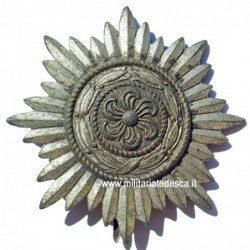- SOLD





Officially designated, Bravery and Merit Decoration for the Eastern People, this series of awards was instituted on July 14TH 1942 to recognize the contribution of volunteers from the Eastern European countries to Germany’s war effort.
The awards were introduced in two classes with five grades and were awarded with swords for bravery in combat, or without swords for outstanding service to the war effort. The awards were rendered in a first class in gold and silver and a second class in gold, silver and bronze and all could be issued with or without swords. The first class awards were the pin back type while the second class awards were suspended from a ribbon.
In October of 1942 bestowal of the first or second class silver award was extended to German nationals serving with "Osttruppen", (Eastern Troops), providing they already held the Iron Cross first or second class.
This badge is die struck, zinc alloy construction award with a silver wash. The reverse has the typical circular depression to the center as found on these awards, a solid, soldered, hinge inset into a rectangular recess, a broad, tapering vertical pin and a heavy soldered catch on a circular base plate inset into a circular recess all intact.
A nice not common badge.
ITALIANO
Questa qui presentata è la medaglia conosciuta con il nome di "Ostvolk" (il cui nome completo in tedesco è: "Tapferkeits- und Verdienst Auszeichnung für Ostvölker") che fu un'onorificenza militare che il Terzo Reich istituì il 14 luglio del 1942 e concesse ai volontari dell'est (Ostvolk in tedesco vuol dire letteralmente popolo dell'est) e doveva premiare tutti coloro che si erano particolarmente distinti sia sul campo di battaglia che non, per sostenere lo sforzo bellico della campagna militare tedesca.
Dal 29 ottobre 1942 anche le truppe tedesche che servivano con le "Osttruppen" o nelle unità combattenti di volontari dell'est, potevano essere eleggibili al ricevimento di questa decorazione di I o II classe in argento, con l'unica clausola che avessero preventivamente ottenuto la croce di ferro di I o II classe.
Questa medaglia venne disegnata da Elmar Lang e divisa in due classi: I classe (oro o argento), II classe (oro, argento o bronzo). La medaglia godeva di due divisioni, una al merito militare sul campo di battaglia (con spade) ed una al merito per eccezionali servigi resi per sostenere lo sforzo bellico (senza spade).
La medaglia era composta da una stella ottagonale avente il centro piano. La prima classe misurava 48 mm di diametro e si poteva agganciare all'uniforme a spilla. La seconda classe misurava 40 mm di diametro e veniva portata appesa ad un nastro di 32 mm.
Une decorazione importante, spesso sottovalutata dai collezionisti, che fu invece ampiamente in uso durante il periodo bellico. Un pezzo non comune.